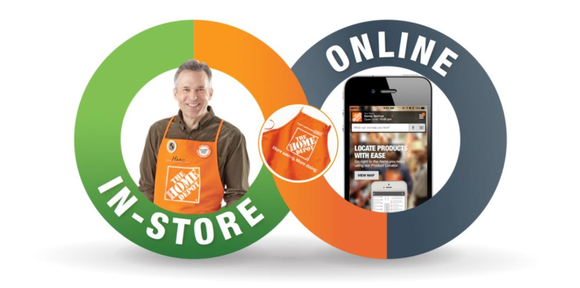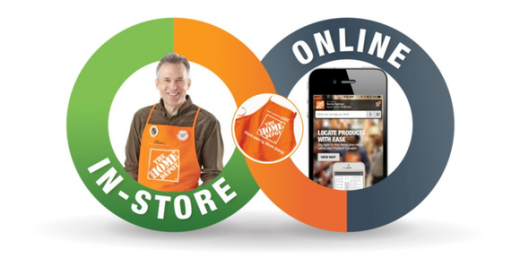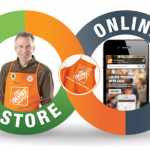How The Home Depot Optimizes Omni-Channel
How The Home Depot Optimizes Omni-Channel
by Laurie Petersen, Columnist, February 27, 2017
Erin Everhart, senior manager of media strategy for The Home Depot, gave an animated and revealing window last week into the “organized chaos” of her day-to-day life at the DIY giant to make the best use of every media dollar.

Speaking at MediaPost’s OMMA Atlanta, she started with a real-life example of how we shop today. Everhart was watching Jimmy Fallon on Hulu when a Roomba commercial came on. She looked at her dog-hair-infested carpet and decided she needed a new vacuum. She wanted the best vacuum money could buy.
In her research phase, Everhart searched many sources, reading articles about dog hair and Consumer Reports in her quest. Then she got a text message and was distracted. She next landed on Reddit in an AMA (Ask Me Anything) from a vacuum repair technician as she tried to make the best possible purchase decision.
Then Everhart started shopping. She looked at 12 different Web sites — the brand directly, retailers, discount sites. She got lost and wound up on Facebook, where she immediately was remarketed for vacuum cleaners. Meanwhile, all of this activity was triggered by one Roomba commercial and that brand never even entered her purchase consideration.
What’s more, Everhart did not buy the vacuum directly. Her mom did. When she found what she wanted, she forwarded the link to her mother who bought it as a Christmas gift.
“No way will this brand be able to trace that purchase to a Roomba commercial,” Everhart said to illustrate her point.
Think ‘Omni’ Not ‘Multi’
Multichannel is a familiar word, but Everhart prefers to use the term “omni-channel” and that’s how The Home Depot seeks to function. She puts it in words anyone can understand. “Multichannel is like having each channel in their own swim lane doing their own thing while omni-channel is one giant pool party. Everyone is understanding and learning, so they can all work better.”
Without some structure, however, things can go wildly out of control. At The Home Depot, there is a two-pronged approach: an integrated media team with three mini-teams. Planning and strategy works directly with the merchandising partners. They determine what are the campaign goals, objectives and messages.
Everhart takes that information and plan to her activation counterpart, who makes the campaign live and conducts real-time optimization to see how it’s working in the marketplace.
The reporting and analytics team takes all the platform side data — platform side insights, stores sales, online sales, traffic, etc., and provides actionable insights that Everhart and her team can present to the merchandising partners.
Each of the three core Home Depot business lines: building materials, hard lines and décor has its own representative from strategy, paid activation, earned media (SEO and content marketing) and analytics. They all work together. This structure has been in place for about a year.
How To Think
When Everhart first gets a campaign, she starts thinking about what she wants to accomplish. What’s the goal? What’s the goal of the individual channel? Each channel should have different media objectives.
Is the goal broad reach? Is it click to conversion? Is it to drive people in-store? If you ask anyone in merchandising, she says, their goal will be sales because that’s their job. It’s her job to ask better, more descriptive questions to really uncover what they want to do.
By how much do they want to increase sales? Do they want customers to buy a specific bundle or to buy more of one particular item than another? Then she starts thinking about the message. Media is historically pigeonholed into what, when and how much spent. But the media channel strategy will vary vastly depending on the messages she’s trying to disseminate.
Say it’s a 20% sale on mulch. You don’t need rich media units to tell that story. So she’ll use radio. It’s easy and it gets people in the store. But what if it’s a bigger more complicated story, say new regulations that have an impact on how you build your deck. That requires a different treatment.
Layered into Everhart’s media planning is seasonality and making sure to complement key Home Depot corporate events and themes. To build awareness, she may use online advertising, PR and content marketing before introducing paid search. People need to be educated on what they’re searching for (say the hypothetical regulations on a new ground contact lumber) before it makes any sense to introduce paid search.
Because there’s an overall campaign strategy, she can optimize appropriately because she knows when everything is running.
On Customers And Retargeting
Everhart also has strong opinions about understanding the customer.
“We have to stop creating these fictitious customer journeys,” she implored the audience. With all the internal and external data that now exists (DMP, etc.) there is no excuse not to understand the audience.
Before putting any campaign in action, Everhart talks to the audience team at The Home Depot. What is the data showing? If a customer bought product A, will they buy product B within 45 minutes or 25 days? For retargeting to actually work, it should relate to how customers behave, not go on auto-pilot.
Selling An Experience
A real business case is selling more ABS pipes to contractors. Everhart works hard to think outside the SKU to make the story relatable. She steps back: What is the overall project that uses these pipes? It’s indoor plumbing. Then she creates a story that tells the contractor everything they need to complete their next bathroom remodeling job.
A challenge is to work with merchants convincing them to allow their media dollars to be used to promote products from other manufacturers outside the category. But it’s worth the fight.
Parting wisdom and insights from Everhart:
- Everything takes a long time. (She’s working on Q3 now.)
- Start taking more strategic planning in-house because no one knows your business as well as you do.
- The No. 1 reason campaigns are delayed or didn’t perform is lack of creative assets, or creative assets that are not good enough.
- Don’t drive customers to a Web site if the message is inconsistent and not properly optimized.
- Stop drowning people in data. Just because you have access to the numbers doesn’t mean you have to suffocate people with them. Use data responsibility.
- The next frontier is search beyond Google — increasingly people are going to Alexa, Pinterest and shopping directly through Amazon Prime.
MediaPost.com: Search Marketing Daily
(75)







